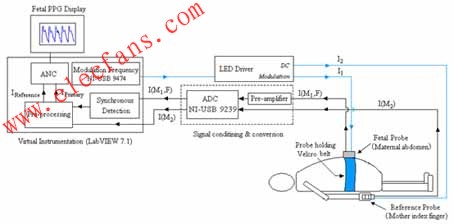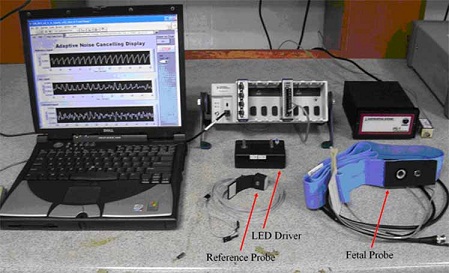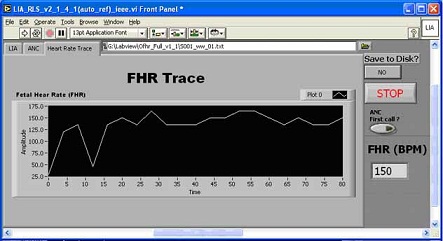Fetal heart rate (FHR) testing is a primary method used to determine the health of the fetus before birth and to help identify potential hazards such as hypoxia or compression. The purpose of early detection is to reduce fetal morbidity and mortality.
At present, the most commonly used method for fetal heart rate detection is Doppler ultrasound, and the standard prenatal fetal health test is fetal no-load test (NST). These tests are usually done in hospitals with continuous wave instruments.
Although the current ultrasonic fetal heart rate detector has been greatly improved, the price continues to decrease, and the volume is more compact, we still need accurate sensor calibration and certain expertise to operate the detector correctly. In addition, such instruments are quite sensitive to movement, and the safety issues that may be caused by long-term exposure of the fetus to ultrasound are not yet conclusive. Therefore, the use of the detector is currently limited to short-term testing.
Another method of measuring fetal heart rate is fetal electrocardiogram (FECG), but the steps are more complicated and less practical. Moreover, there is currently no commercially available non-invasive FECG equipment on the market.
Recently, someone has proposed an optical method that is still in the research stage. This method uses a halogen lamp or a tungsten filament lamp as a light source to realize detection by photomultiplier. However, these technologies are costly, require high light intensity, and are difficult to implement due to limitations in instrument size and power consumption.
Optical fetal heart rate detection system
Our research team proposed a low-power optical technology based on the photoelectric blood vessel volume map (PPG) signal to detect fetal heart rate non-invasively. The PPG signal is generated by light modulated by blood pulsation. The doctor or technician illuminates the pregnant woman's abdomen with LED lights (less than 68 mW), and the light beam is modulated by the blood circulation of the mother and fetus. The maximum light wavelength that can penetrate is 890 nm. The mixed signal can be analyzed by using adaptive filtering obtained by digital signal processing, and the index finger PPG of the pregnant woman is used as a reference input.
Using LabVIEW graphical system design software and NI hardware to develop an optical fetal heart rate (OFHR) detection system. In the OFHR system, the SNR decreases as the incident power decreases; the excitation signal is the modulated beam. The system can implement synchronous detection. The software subroutine in LabVIEW uses the NI 9474 digital output module to generate the modulation frequency at the counter.
At the receiver, low-noise amplification and synchronization detection ensure that useful information is saved with minimum noise power. The 24-bit NI USB-9239 analog-to-digital converter (ADC) reduces the effects of quantization noise. Once the digitization is completed, the signal is processed by adaptive noise canceller (ANC) technology to extract the fetal PPG from the mixed signal.
Connect the fetal probe (main signal) to the pregnant woman's abdomen with a waist belt to keep the IR-LED and the photodetector at a distance of 4 cm. Connect the reference probe to the mother's index finger. Since the selected IR-LED can only emit a maximum power of 68 mW, the operating optical power of the OFHR system is set to be less than 87 mW specified by the International Commission on Non-Ionizing Radiation Protection (ICNIRP). In order to modulate the IR-LED, a software subroutine is used to generate a 725 Hz modulated signal, which is connected to the LED driver via the NI 9474 counter terminal (Figure 1). In Figure 1, the diffuse reflected light of the pregnant woman's abdomen is measured by a low-noise photodetector and expressed as I (M1, F), where M1 and F represent the influence of the mother's abdomen and fetus on the signal, respectively.

Figure 1: The hardware module in the OFHR system block diagram is implemented by LabVIEW program
A low-noise (6 nV / Hz1 / 2) transimpedance amplifier converts current into voltage. The reference probe (connected to the mother's index finger) consists of an IR-LED and a solid-state photodiode with a built-in preamplifier. The signal from this probe is represented as I (M2); M2 represents the influence of the mother on the signal. This channel does not need to be detected synchronously because the photoelectric volume map of the index finger has a high signal-to-noise ratio (SNR).
The NI USB-9239 24-bit resolution data acquisition module simultaneously acquires signals from two probes at a rate of 5.5 kHz. Perform demodulation, signal filtering and signal estimation in the digital domain. The software implementation includes modulation signal generation, synchronization detection algorithm, downsampling, high-pass filtering, and adaptive noise cancellation (ANC) algorithm.
The design team used LabVIEW to implement the entire algorithm and some instruments. After completing the preprocessing and application of the ANC algorithm, LabVIEW will display the results of fetal signal and fetal heart rate.
Figure 2a shows the laboratory prototype and graphical user interface of the OFHR system, and gives the index finger PPG (top), abdomen PPG (middle), and fetal estimated PPG (bottom) of the pregnant woman.

Figure 2a: OFHR prototype
Figure 2b shows three optional displays, including digital synchronous or lock-in amplifier (LIA), adaptive noise canceller (ANC), and heart rhythm trajectory. The first two displays can be used to assist development, and the third display is used to indicate the value of fetal heart rate relative to time. Users can observe the data online or save it for further analysis.

Figure 2b: Graphical user interface of OFHR system
After the development was completed, we tested the functionality of the system based on a total of 24 sets of data from 6 clinical subjects ranging from 35 to 39 weeks pregnant. The data was provided by the National University of Malaysia Medical Center. All the fetuses participating in this study were examined by obstetricians in a healthy state and were free from complications at birth.
In the study, we obtained a correlation coefficient of 0.97 (p value less than 0.001) between optical and ultrasonic fetal heart rate, with a maximum error of 4%. Clinical results show that the closer the probe is to fetal tissue (not limited to the brain or buttocks), the more the signal quality and detection accuracy can be improved.
in conclusion
The research team developed a new type of OFHR detection system using low-cost, low-power IR lamps and commercially available silicon detectors. By using LabVIEW, we can quickly and easily implement digital synchronization detection and adaptive filtering technology. Compared with the standard measurement method (Doppler ultrasound), the accuracy of our measured fetal heart rate results is higher. Based on the novelty of the solution, we are currently applying for a patent for its commercial use.
Lcd Sreen Vacuum Cleaner,Lcd Touch Screen,Plasma Cleaner,Four Color Robot Vacuum Cleaner
NingBo CaiNiao Intelligent Technology Co., LTD , https://www.intelligentnewbot.com